Nursing Interventions of Women with Osteoporosis
Added on 2023-06-03
36 Pages5697 Words87 Views
Running Head: Nursing Interventions
NURSING INTERVENTIONS OF THE WOMEN WITH OESTOPROSIS
Name:
Academic Affiliation:
Date:
NURSING INTERVENTIONS OF THE WOMEN WITH OESTOPROSIS
Name:
Academic Affiliation:
Date:
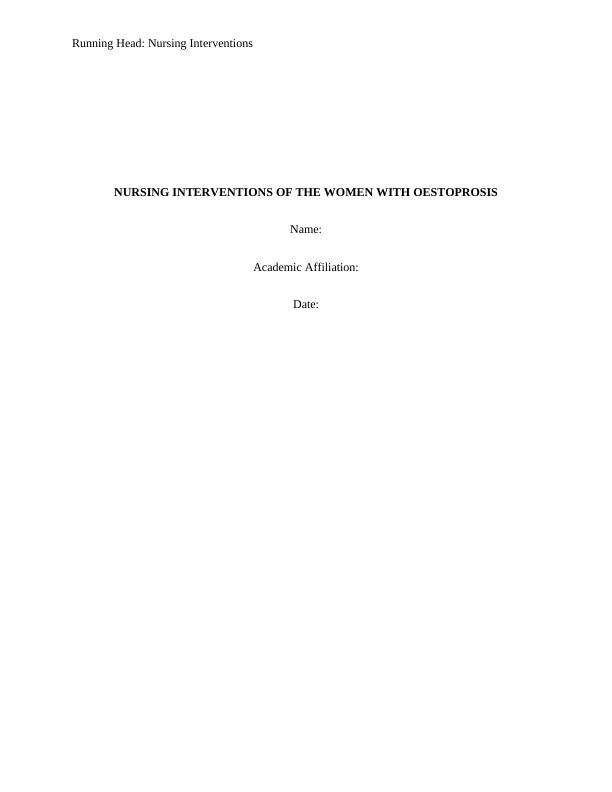
Nursing Interventions 2
The significance of the study
Osteoporosis refers to a skeletal medical condition of decreased bone’ density and
strength, resulting in bone fragility. Osteoporosis makes the bones to be porous and compressible
like a sponge, weakening and making it susceptible to breakages from minor falls or bumps
(Aggarwal & Masuda, 2018). These type of fractures that results from the reduced bone strength
are referred to as ‘fragility fractures’ and are always found among many people across the world.
Research shows that one out of two women and one out of five men above the ages of 50 are
susceptible to the fragility fractures around many parts of the body such as the wrist, hips, spine
among many others.
A normal bone comprises of collagen, protein, and calcium that offers its strength. Bones
have numerous functions such as the provision of the support, structure protection of the internal
organize storage of calcium and other mineral elements and contain bone marrow that act as
blood cells producers. This means that any medical condition that affects the functionality of the
bone renders the body to numerous diseases, functionality, and even death. Above the ages of 35
years, the is an imbalance on the amount of bone being removed, and the amount of that is laid
down as a result of the aging process, a process known as ‘bone thinning’. The bones from the
outside look the same, however, from the inside the cortical shell reduces, and the struts become
thinner hence leading to the probability of fractures (Vipey et al., 2015). As indicated earlier,
osteoporosis occurs in both women; however, it is much common among older women due to the
high rate of bone loss during the menopause period and when the sex hormones level drop down.
During the adolescent, the human’s bone structure is always strong with enough mass to
sustain the body weight and any bump, however, after some ages of 55 years, the estrogen
The significance of the study
Osteoporosis refers to a skeletal medical condition of decreased bone’ density and
strength, resulting in bone fragility. Osteoporosis makes the bones to be porous and compressible
like a sponge, weakening and making it susceptible to breakages from minor falls or bumps
(Aggarwal & Masuda, 2018). These type of fractures that results from the reduced bone strength
are referred to as ‘fragility fractures’ and are always found among many people across the world.
Research shows that one out of two women and one out of five men above the ages of 50 are
susceptible to the fragility fractures around many parts of the body such as the wrist, hips, spine
among many others.
A normal bone comprises of collagen, protein, and calcium that offers its strength. Bones
have numerous functions such as the provision of the support, structure protection of the internal
organize storage of calcium and other mineral elements and contain bone marrow that act as
blood cells producers. This means that any medical condition that affects the functionality of the
bone renders the body to numerous diseases, functionality, and even death. Above the ages of 35
years, the is an imbalance on the amount of bone being removed, and the amount of that is laid
down as a result of the aging process, a process known as ‘bone thinning’. The bones from the
outside look the same, however, from the inside the cortical shell reduces, and the struts become
thinner hence leading to the probability of fractures (Vipey et al., 2015). As indicated earlier,
osteoporosis occurs in both women; however, it is much common among older women due to the
high rate of bone loss during the menopause period and when the sex hormones level drop down.
During the adolescent, the human’s bone structure is always strong with enough mass to
sustain the body weight and any bump, however, after some ages of 55 years, the estrogen
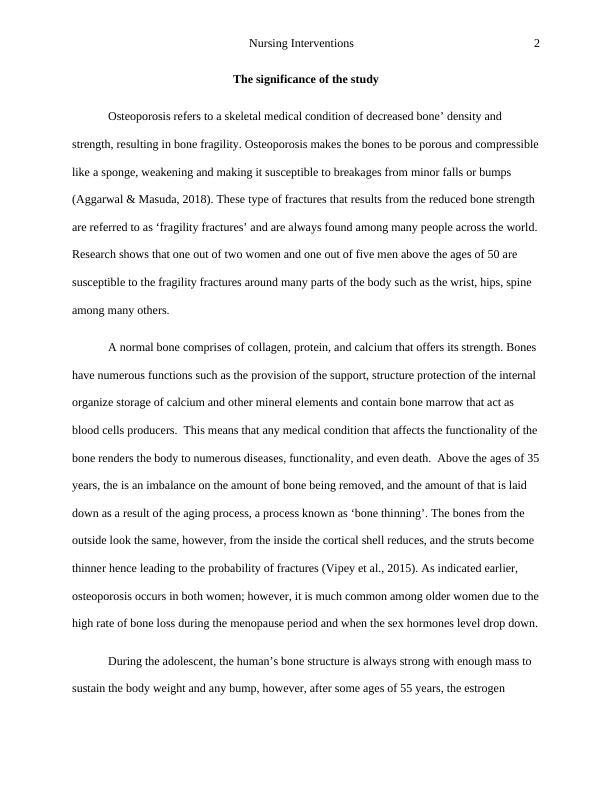
Nursing Interventions 3
hormone that protects the bone loss is reduced. After the menopause, the ovaries stop producing
the estrogen leading to high-risk factors among the women thus making an average of about 34%
women against 17% of men worldwide (Nixon et al., 2016). Over 200 million of women quality
of life is seriously jeopardized with the increasing rate of osteoporosis in the world and with the
high rate of aging population, there is need to have health interventions to provide guidance and
care for them. In the European Union, osteoporosis cost above € 37 billion with some victims
projected to increase shortly. The high population of sufferers puts many countries in the world
to have large expenditure on the health conditions hence the formations of numerous
organizations such as National Osteoporosis Foundation (NOF), and International Osteoporosis
Foundations (IOF) (Shams-White et al., 2018). Such organizations, work worldwide to create
awareness of the knowledge about osteoporosis with an aim to reduce the prevalence among the
populations.
The diagnosis of osteoporosis occurs through the measure of bone loss by the use of Dual
Energy X-ray, and DXA test that always takes about 15 minutes. A T-score that ranges between -
2.5 and lower requires intervention depending on the doctor's interpretation.
Figure 1 shows changes in bone mass against age, obtained from (Vipey et al., 2015)
hormone that protects the bone loss is reduced. After the menopause, the ovaries stop producing
the estrogen leading to high-risk factors among the women thus making an average of about 34%
women against 17% of men worldwide (Nixon et al., 2016). Over 200 million of women quality
of life is seriously jeopardized with the increasing rate of osteoporosis in the world and with the
high rate of aging population, there is need to have health interventions to provide guidance and
care for them. In the European Union, osteoporosis cost above € 37 billion with some victims
projected to increase shortly. The high population of sufferers puts many countries in the world
to have large expenditure on the health conditions hence the formations of numerous
organizations such as National Osteoporosis Foundation (NOF), and International Osteoporosis
Foundations (IOF) (Shams-White et al., 2018). Such organizations, work worldwide to create
awareness of the knowledge about osteoporosis with an aim to reduce the prevalence among the
populations.
The diagnosis of osteoporosis occurs through the measure of bone loss by the use of Dual
Energy X-ray, and DXA test that always takes about 15 minutes. A T-score that ranges between -
2.5 and lower requires intervention depending on the doctor's interpretation.
Figure 1 shows changes in bone mass against age, obtained from (Vipey et al., 2015)

Nursing Interventions 4
Question for the Literature Review
What are the nursing interventions of women with osteoporosis?
Search Strategy
Evidence will be conducted through the use of Medline, CINNAL and Scopus database
systems that are accessible from the University of Wollongong Library. Other sources search
such as Google scholars were used to collect the required information. Based on the search
question, the nursing interventions on women with osteoporosis, search terms were derived:
Osteoporosis, nursing interventions and osteoporosis among women.
The study is limited in the English language published between 2014 and 2018 and
focused on women between the age of 55 years and above. The study found 25 nursing journal
articles of which 15 met the selection criteria and were analyzed to come up with the full
literature review on the topic.
Summary of the evidence
The studies are examined based on the following two interventions: educational and
medical. The educational intervention focuses on the self-efficacy while the medical
interventions focus on the use of drugs and estrogen replacement therapy.
Osteoporosis educational intervention
Health education plays a significant role in the public as it aims at preventing the spread
of diseases and the improvement of people’s lives through the dissemination of information.
Health education entails combinations of learning experiences that are undertaken by different
stakeholders in promoting a healthy lifestyle. The study conducted by Stupar, Radojčić, Tadić,
Question for the Literature Review
What are the nursing interventions of women with osteoporosis?
Search Strategy
Evidence will be conducted through the use of Medline, CINNAL and Scopus database
systems that are accessible from the University of Wollongong Library. Other sources search
such as Google scholars were used to collect the required information. Based on the search
question, the nursing interventions on women with osteoporosis, search terms were derived:
Osteoporosis, nursing interventions and osteoporosis among women.
The study is limited in the English language published between 2014 and 2018 and
focused on women between the age of 55 years and above. The study found 25 nursing journal
articles of which 15 met the selection criteria and were analyzed to come up with the full
literature review on the topic.
Summary of the evidence
The studies are examined based on the following two interventions: educational and
medical. The educational intervention focuses on the self-efficacy while the medical
interventions focus on the use of drugs and estrogen replacement therapy.
Osteoporosis educational intervention
Health education plays a significant role in the public as it aims at preventing the spread
of diseases and the improvement of people’s lives through the dissemination of information.
Health education entails combinations of learning experiences that are undertaken by different
stakeholders in promoting a healthy lifestyle. The study conducted by Stupar, Radojčić, Tadić,

Nursing Interventions 5
and Pavlov-Dolijanović on the Osteoporosis-related knowledge among 132 Serbian
postmenopausal women aimed at identifying the effect of education of osteoporosis on women.
The role of osteoporosis education among women is to provide information to affect the beliefs,
attitudes and intervention behavior with a major aim to reduce the prevalence of bone fracture
(Stupar et al., 2017).
Numerous shows that inadequate knowledge about osteoporosis and risk factors increase
the chances of prevalence by about 39% as the women are unable to determine their risks of
developing the disease and changing the health-related behaviors (Toh eta l., 2015). The
education of osteoporosis prevention can be divided into two: that is knowledge of osteoporosis
measurement and the prevention behavior. During the education, women are taught more about
osteoporosis with a major focus on the bone anatomy, self-management principles, personal goal
setting, pain management, relaxation, nutrient, posture, working with doctors and medication,
osteoporosis risk factors, measurement of bone density, and support from groups among many
others.
Self-efficacy
Self-efficacy refers to personal confidence in performing a particular behavior in
numerous situations (Ki-Soo et al., 2017). In studies conducted on the role of education on the
osteoporosis, whereby the all the participants were all women from various profession and
institutions, self-efficacy was found as the major contributor to the management of the diseases.
Janiszewska, Kulik, Żołnierczuk-Kieliszek, Drop, Firlej and Gajewska, conducted a study on
151 women who have undergone educational training and conclude that self-efficacy is
instrumental in the treatment.in health education, self-efficacy entails different factors such as
and Pavlov-Dolijanović on the Osteoporosis-related knowledge among 132 Serbian
postmenopausal women aimed at identifying the effect of education of osteoporosis on women.
The role of osteoporosis education among women is to provide information to affect the beliefs,
attitudes and intervention behavior with a major aim to reduce the prevalence of bone fracture
(Stupar et al., 2017).
Numerous shows that inadequate knowledge about osteoporosis and risk factors increase
the chances of prevalence by about 39% as the women are unable to determine their risks of
developing the disease and changing the health-related behaviors (Toh eta l., 2015). The
education of osteoporosis prevention can be divided into two: that is knowledge of osteoporosis
measurement and the prevention behavior. During the education, women are taught more about
osteoporosis with a major focus on the bone anatomy, self-management principles, personal goal
setting, pain management, relaxation, nutrient, posture, working with doctors and medication,
osteoporosis risk factors, measurement of bone density, and support from groups among many
others.
Self-efficacy
Self-efficacy refers to personal confidence in performing a particular behavior in
numerous situations (Ki-Soo et al., 2017). In studies conducted on the role of education on the
osteoporosis, whereby the all the participants were all women from various profession and
institutions, self-efficacy was found as the major contributor to the management of the diseases.
Janiszewska, Kulik, Żołnierczuk-Kieliszek, Drop, Firlej and Gajewska, conducted a study on
151 women who have undergone educational training and conclude that self-efficacy is
instrumental in the treatment.in health education, self-efficacy entails different factors such as
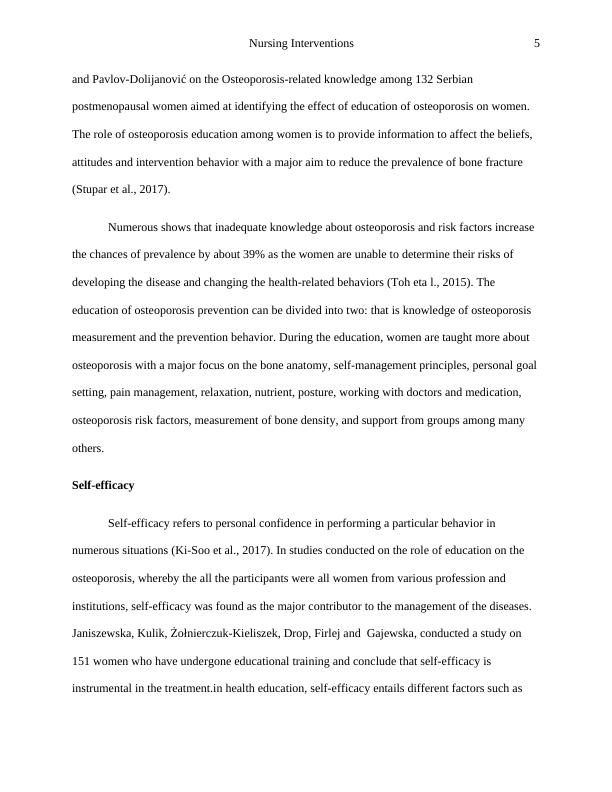
Nursing Interventions 6
knowledge, attitude skills, and behavior change (Janiszewska et al., 2017). Among these factors,
behavior change is the fundamental of self-efficacy and has been used among many programs
and interventions. Self-efficacy is influenced by four main sources that are: mastery experience,
vicarious experience, verbal persuasion, and physiological and emotional states.
Mastery experience influences self-efficacy through all the successful experiences, while
repeated failures reduce/lowers self-efficacy (Elders et al., 2017). The osteoporosis education,
allows women to have experiences in keeping the calcium, vitamin and other nutrients intake
diary or even having regular weight-bearing exercises to prevent osteoporosis. The success of
these educational experiences and mastery of the techniques increase the self-efficacy of the
participants that eventually help them to reduce while at home or even after the education
system.
The vicarious experiences help in improving self-efficacy through seeing people of the
similar condition who are strong. Through osteoporosis education, groups are always formed to
enhance the participant’s belief about the effect of doing various activities that have made other
people manage the condition. The verbal persuasion is used by health education professionals to
disseminate reliable and persuasive information. The verbal encouragement during the
educational intervention increases the self-efficacy of the women to achieve the set goals in
managing the medical condition. Lastly, the physiological and emotional status helps in
increasing the positive mood of depressed women.
Studies show that self-efficacy creates the behavior change leading to increased rate of
weight-bearing exercise and calcium intake increases the strength of the bone. However, some
knowledge, attitude skills, and behavior change (Janiszewska et al., 2017). Among these factors,
behavior change is the fundamental of self-efficacy and has been used among many programs
and interventions. Self-efficacy is influenced by four main sources that are: mastery experience,
vicarious experience, verbal persuasion, and physiological and emotional states.
Mastery experience influences self-efficacy through all the successful experiences, while
repeated failures reduce/lowers self-efficacy (Elders et al., 2017). The osteoporosis education,
allows women to have experiences in keeping the calcium, vitamin and other nutrients intake
diary or even having regular weight-bearing exercises to prevent osteoporosis. The success of
these educational experiences and mastery of the techniques increase the self-efficacy of the
participants that eventually help them to reduce while at home or even after the education
system.
The vicarious experiences help in improving self-efficacy through seeing people of the
similar condition who are strong. Through osteoporosis education, groups are always formed to
enhance the participant’s belief about the effect of doing various activities that have made other
people manage the condition. The verbal persuasion is used by health education professionals to
disseminate reliable and persuasive information. The verbal encouragement during the
educational intervention increases the self-efficacy of the women to achieve the set goals in
managing the medical condition. Lastly, the physiological and emotional status helps in
increasing the positive mood of depressed women.
Studies show that self-efficacy creates the behavior change leading to increased rate of
weight-bearing exercise and calcium intake increases the strength of the bone. However, some
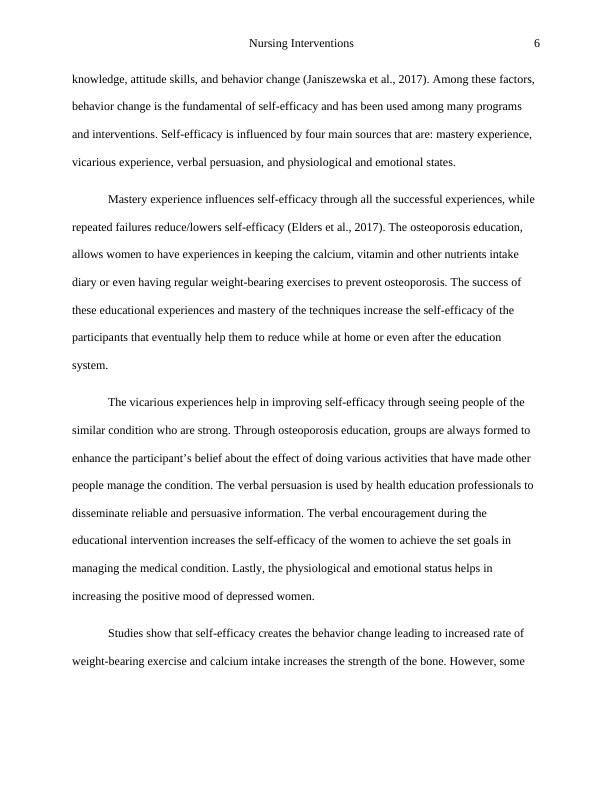
Nursing Interventions 7
studies also report that weight-based exercise is less effective among the older women who feel
too old to perform the activities hence are only left with nutrition intervention.
Nutrition and osteoporosis
A healthy diet is important throughout the life in building the strong bones and reduction
of the strength. Women are always taught to feed adequately during childhood and after the
menopause period to provide a better chance of the bones to withstand a loss in the old age.
Calcium foods such as milk, cheese, baked beans, and rice among many others makes the bones
strong (Bharathi & Baby, 2017). Vitamin D foods such as sunlight, grilled salmon, soya milk,
boiled chicken egg help to regulate the way the body uses calcium in the body. Women are
taught how to select rich foods to enhance their dietary intake through calcium and vitamin rich
food choosers.
Exercise and osteoporosis
Exercise helps in building strong bones during the early years and helps in increasing the
strength of the bones through life. Bone is living tissues that are affected by the forces and loads
put upon it by becoming stronger. Constant and frequent body movement causes the muscles to
pull on the bones, increasing the strength hence reducing the probability of experiencing any fall.
During education, women are taught on what kind of exercise is right for them since the choice
of the wrong exercise might lead to fracture (Svege et al., 2016). For example, a woman with
high fracture risk is prone to fragility hence jogging exercise is not recommended. Therefore nay
choice of exercise must be tailored according to each patient’s situation as discusses by doctors
and physiotherapist.
studies also report that weight-based exercise is less effective among the older women who feel
too old to perform the activities hence are only left with nutrition intervention.
Nutrition and osteoporosis
A healthy diet is important throughout the life in building the strong bones and reduction
of the strength. Women are always taught to feed adequately during childhood and after the
menopause period to provide a better chance of the bones to withstand a loss in the old age.
Calcium foods such as milk, cheese, baked beans, and rice among many others makes the bones
strong (Bharathi & Baby, 2017). Vitamin D foods such as sunlight, grilled salmon, soya milk,
boiled chicken egg help to regulate the way the body uses calcium in the body. Women are
taught how to select rich foods to enhance their dietary intake through calcium and vitamin rich
food choosers.
Exercise and osteoporosis
Exercise helps in building strong bones during the early years and helps in increasing the
strength of the bones through life. Bone is living tissues that are affected by the forces and loads
put upon it by becoming stronger. Constant and frequent body movement causes the muscles to
pull on the bones, increasing the strength hence reducing the probability of experiencing any fall.
During education, women are taught on what kind of exercise is right for them since the choice
of the wrong exercise might lead to fracture (Svege et al., 2016). For example, a woman with
high fracture risk is prone to fragility hence jogging exercise is not recommended. Therefore nay
choice of exercise must be tailored according to each patient’s situation as discusses by doctors
and physiotherapist.
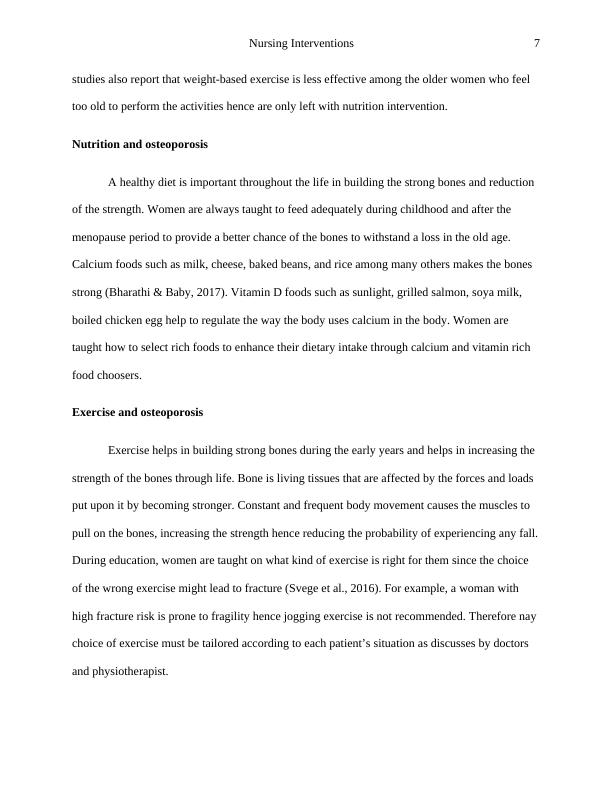
Nursing Interventions 8
Osteoporosis Medical intervention
The high rate of osteoporosis among the post-menstrual results from the estrogen
deficiency that accelerate the bone turnover, thus enhancement of the parathyroid hormones
(PTH) increase the intake of calcium and vitamin among the women; promoting the osteoclast
process. Study conducted by Ciumărnean, Milaciu, Alb, Moldovan and Sâmpelean,
conducted a research on 4235 participants and found out that increase on the drug’s use
increased the bone mineral density.
Estrogen replacement
Due to the roles of estrogen receptors in the osteoclast apoptosis, estrogen replacement
therapy is a significant way of preventing osteoporosis among the post-menopausal women.
Numerous studies indicate that lumbar spine, femoral neck, and total hip-bone mass density
changes through the hormonal replacement therapy are hence reducing the bone turnover
(Costello, Sprung & Coulter, 2017). However, due to high-risk factors such as thromboembolic
disorders, stroke, and endometrial cancers among others, the process is not recommended as a
first measure of osteoporosis treatment.
Selective estrogen receptor modulators such as lasofoxifene, raloxifene and bazedoxifene
are also used to improve the estrogen in the body. These are FDA approved non-steroid synthetic
drugs that reduce vertebral fracture among the osteoporosis women by increasing the trabecular
bone mass in the axial skeleton.
Oral drugs
Osteoporosis Medical intervention
The high rate of osteoporosis among the post-menstrual results from the estrogen
deficiency that accelerate the bone turnover, thus enhancement of the parathyroid hormones
(PTH) increase the intake of calcium and vitamin among the women; promoting the osteoclast
process. Study conducted by Ciumărnean, Milaciu, Alb, Moldovan and Sâmpelean,
conducted a research on 4235 participants and found out that increase on the drug’s use
increased the bone mineral density.
Estrogen replacement
Due to the roles of estrogen receptors in the osteoclast apoptosis, estrogen replacement
therapy is a significant way of preventing osteoporosis among the post-menopausal women.
Numerous studies indicate that lumbar spine, femoral neck, and total hip-bone mass density
changes through the hormonal replacement therapy are hence reducing the bone turnover
(Costello, Sprung & Coulter, 2017). However, due to high-risk factors such as thromboembolic
disorders, stroke, and endometrial cancers among others, the process is not recommended as a
first measure of osteoporosis treatment.
Selective estrogen receptor modulators such as lasofoxifene, raloxifene and bazedoxifene
are also used to improve the estrogen in the body. These are FDA approved non-steroid synthetic
drugs that reduce vertebral fracture among the osteoporosis women by increasing the trabecular
bone mass in the axial skeleton.
Oral drugs
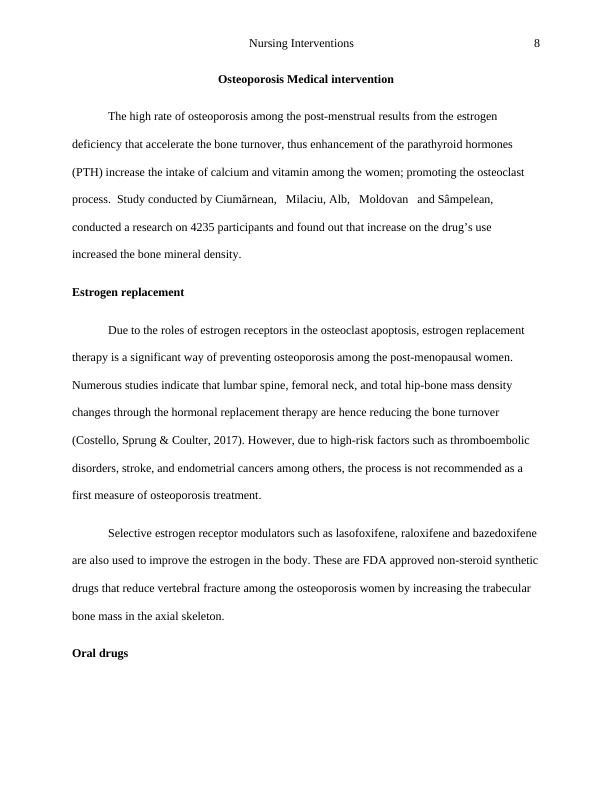
End of preview
Want to access all the pages? Upload your documents or become a member.
Related Documents
Osteoporosis: Prevalence, Risk Factors, and Preventionlg...
|9
|1688
|420
Epidemiology of Non-Communicable Diseaseslg...
|7
|1494
|108
Prevention and Impacts of Osteoporosis in Ageing Populationlg...
|20
|5384
|111
Evaluation of Osteoporosis Awareness Among Post-Menopausal Womenlg...
|21
|5076
|422
Osteoporosis - Causes, Complications and Managementlg...
|7
|1572
|149
Nursing Care Practice; a Case Studylg...
|10
|3771
|440
